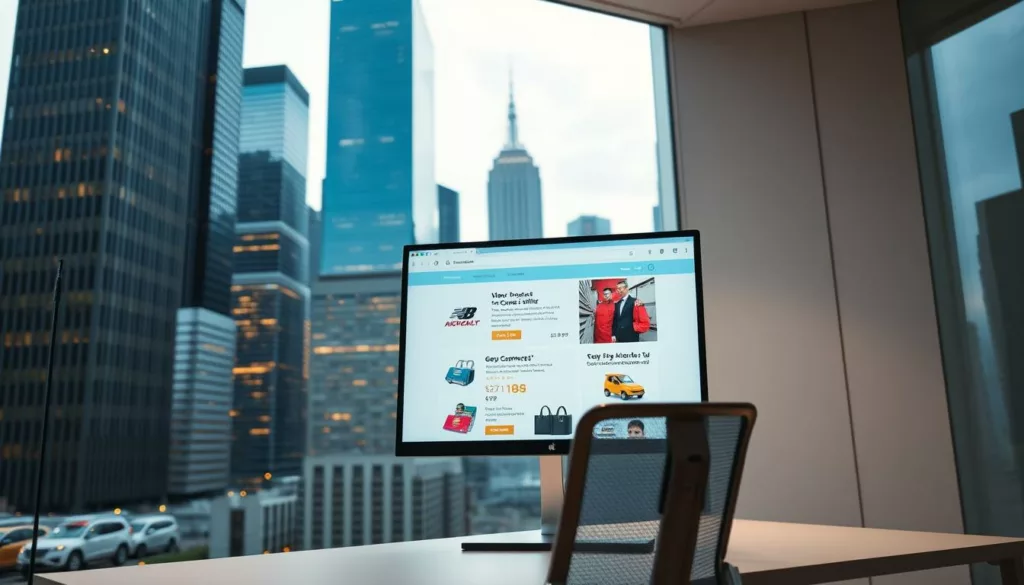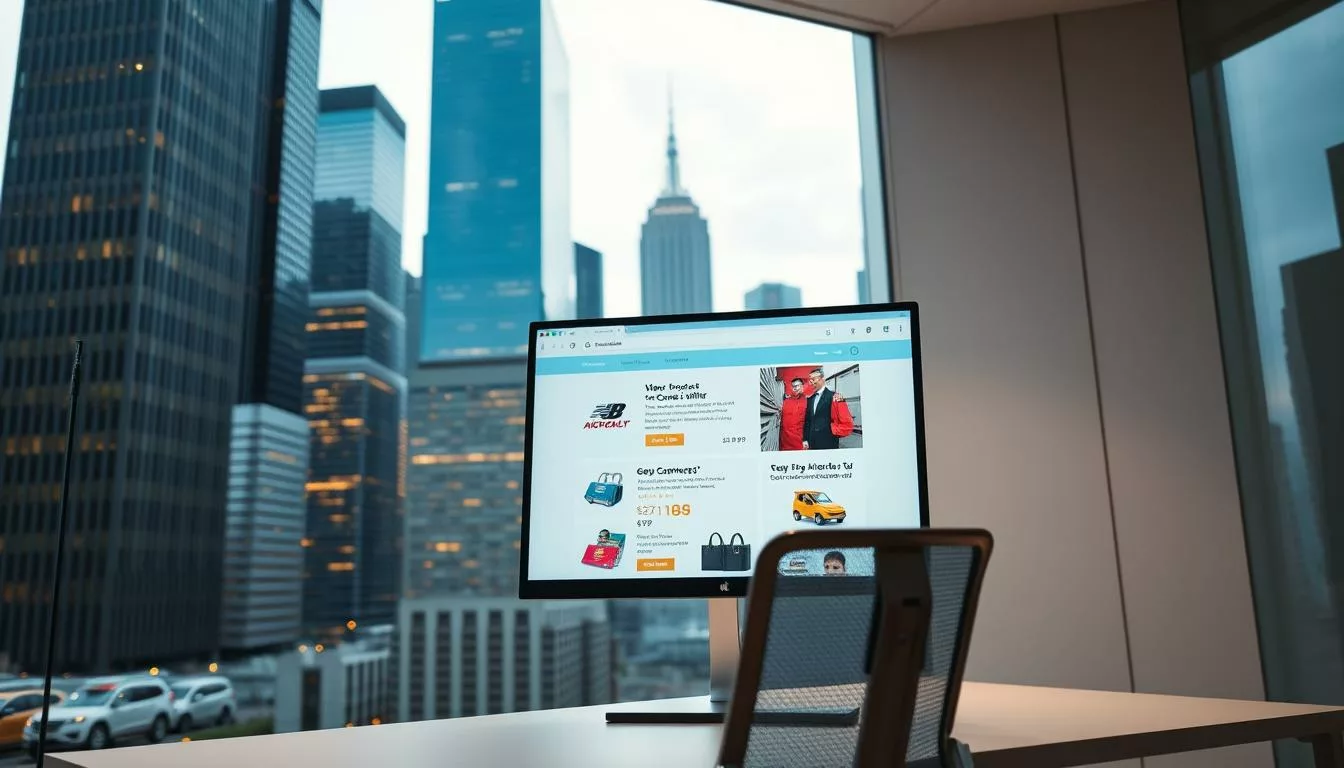
Geotargeting is a core pillar for online stores that want to match offers, content, and merchandising to local demand across the United States today.
This guide aims to link regional data to real outcomes — from conversion and average order value to profitability. You will get a clear roadmap for practical rollout, with phased milestones and cross‑functional ownership.
We cover how your website and store stack must support geo logic across templates, product pages, promotions, and checkout so customers move from visit to conversion.
Performance matters. Faster pages convert more: sites with a one‑second load convert about 2.5x more visitors than five‑second pages. We’ll show how to target slow regions based on device and network realities.
Search and navigation will adapt to local terms and inventory to cut bounce and help shoppers find what they need. Free shipping signals are crucial too: nine in ten consumers rate free shipping as a top incentive.
Expect hands‑on steps for testing, measurement, and marketing alignment so campaigns, creatives, and landing content match regional value and compliance needs.
Key Takeaways
- Geotargeting aligns content, offers, and merchandising to local demand.
- Site speed drives conversion — fix slow regions first.
- Local search and navigation reduce lost opportunities and bounce.
- Coordinate marketing and creatives to regional value props.
- Measure by market, run tests, and track financial impact.
- Phase rollouts with clear goals and cross‑team ownership.
Why Geotargeting Matters Today for E-commerce Sales Optimization in the United States
Regional signals turn generic web pages into locally relevant experiences that measurably lift conversion and order value.
Linking location data to conversion rate, AOV, and profitability
State, DMA, city, and store-radius signals let a brand tailor the website for different customers. That tailoring drives higher engagement and better conversion rates where it matters most.
Fast pages matter: sites with a one-second load convert roughly 2.5x better than at five seconds. Prioritize performance in top-revenue DMAs to protect business margin.
Shipping costs shift by zone. Clothing retailers can spend ~13% of revenue on shipping, so local rate strategies and pickup options raise average order value and margin.
- Use regional benchmarks to spot markets where small site changes yield big profit lifts.
- Align marketing and website incentives to local delivery costs to avoid margin erosion.
- Leverage location insights from analytics to promote the right categories and offers per store footprint.
Device and connection differences also vary by region. Improving regional performance directly improves conversion for mobile shoppers near your warehouses.
Start small: pilot in top DMAs, validate lift with incrementality tests, then scale geo logic across the store footprint. Keep governance tight so leadership sees clear insights from today’s pilots before expanding nationwide.
Understanding User Intent by Location: Turning Visitors into Customers
Understanding local intent turns generic pages into timely offers that answer a visitor’s immediate need.
“Forrester finds roughly 50% of potential sales can be lost when users can’t find what they need.”
Map regional goals to content and products. Climate, seasonality, and local events change what shoppers want. A coastal city may seek lightweight gear while a mountain town needs insulated layers.
Mapping intent to experience
Use on-site search queries, filters, and click maps to spot where visitors from specific DMAs struggle. Heatmaps reveal navigation gaps that hurt conversion.
Serve regionally relevant collections and product pages with local availability. Show pickup or delivery options up front to reduce friction and speed the path to purchase.
Local content and testing
Swap modular hero content by market to reflect holidays, trends, or urgency. Use placements like “Trending near you” or “Top-rated in [City]” to add social proof and local relevance.
- Prioritize taxonomies and synonyms that match local vocabulary.
- Tailor product recommendations to regional use cases, not just global popularity.
- Test page length and content density by market to preserve a strong user experience.
When you align navigation, content, and fulfillment to local intent, customers find the right product faster and conversion improves.
Data Foundations: Analytics, Segmentation, and Geo Signals That Power Personalization
Good regional data is the backbone that turns broad traffic into measurable, local gains.
Start with a clear tracking plan. Configure Google Analytics with consistent geo tags: state, DMA, and ZIP-to-DMA mapping. This lets teams compare visitors, conversion rate, and revenue by market.
Setting up geo-aware tracking, on-site search insights, and heatmaps
Instrument the site and website events to capture fulfillment choices, payment methods, and device mix per region. Use heatmaps and click tracking to spot scroll and click patterns that differ by network or device.
Building segments by state, DMA, and store radius
Build segments by state, DMA, and store radius to power personalization for content modules and product carousels. Feed these segments into A/B tests so experiments reflect local behavior, not national averages.
- Integrate on-site search queries to refine synonyms and ranking rules by market.
- Track product view-to-purchase, out-of-stock impact, and returns per region.
- Create pipelines joining shipping zones and delivery SLAs to experience logic.
| Region | Visitors/day | Conversion Rate | Top Fix |
|---|---|---|---|
| DMA: NY Metro | 12,400 | 2.8% | Faster mobile assets |
| State: Texas | 8,100 | 2.1% | Adjust shipping thresholds |
| Store Radius: 25mi | 3,200 | 3.5% | Promote pickup options |
Keep event names and taxonomy consistent as you scale. And ensure privacy and compliance so granular geo insights stay available for smart business decisions.
Site Performance and UX by Region: Speed, Navigation, and Mobile Experience
Prioritizing bandwidth and navigation by market turns visits into measurable growth.
Target high-converting DMAs first. Focus performance sprints where traffic and revenue matter most. A one-second load converts about 2.5x more than five seconds, so regional speed budgets deliver quick wins for growth and sales.
Prioritizing site speed for high-converting regions
Optimize Core Web Vitals with geo-aware testing. Account for device, carrier, and network quality so the site works for all customers.
- Use lazy loading, image compression, and a CDN routed by latency to keep product visuals fast.
- Trim unnecessary scripts and pick reliable hosting (for example, Kinsta) to steady performance.
- Keep mobile-first templates and accessible layouts so shoppers on low bandwidth can complete checkout.
- Streamline navigation and make search prominent to fix the 50% findability gap and help customers find products faster.
Measure and scale. Build DMA-specific dashboards, leverage pattern libraries for UI changes, and show leadership how speed work compounds conversion and regional sales.
Product Pages That Convert Locally: Content, Imagery, and Social Proof
Product pages that reflect a buyer’s local context close more purchases than generic listings. Use clear headlines, tailored benefits, and imagery that shows the product in local settings to build instant trust.
Local reviews, UGC, and credibility signals by market
Surface reviews from the shopper’s state or DMA first. Local testimonials and UGC increase relevance and make the product feel proven in the customer’s neighborhood.
Geo-dynamic badges: availability, pickup, and delivery windows
Show live availability badges, pickup time windows, and region-specific delivery ETAs. These signals cut uncertainty and lift conversion rate by clarifying when products arrive.
- Use structured data for local stock and pickup to boost search visibility.
- Highlight warranties, returns, and SLAs tuned to regional expectations.
- Test sticky CTAs, add-to-cart placement, and trust badges by market to balance clarity and speed.
| Feature | Local Benefit | Example Module |
|---|---|---|
| Local Reviews | Greater trust, higher conversions | “Loved in Austin: 4.8 stars” |
| Pickup Badge | Reduces delivery anxiety | “Ready for pickup in 2 hours” |
| Regional Imagery | Better product fit perception | “Works great for Pacific Coast gardening” |
Personalized Product Recommendations with Geotargeting
Personalized recommendations that respect location boost relevance and basket size for local shoppers.

Use geo-aware rules plus AI to show items that reflect local demand. Around 68% of online shops’ revenue comes from related product recommendations like “visitors who viewed this product also viewed.” Add recently viewed and cross-sell bundles to improve discovery and increase basket size.
Rules and AI: local affinity logic
Build carousels that read “Shoppers near you also bought” and tie them to SKU availability. Combine machine learning with simple business rules to filter out unavailable items and favor SKUs with strong regional conversion signals.
- Local bundles: weather or event-driven kits that match DMA trends.
- Placements: PDP, cart, and homepage modules with tailored messaging.
- Performance: throttle widgets so only top placements load to protect page speed.
Sync on-site recommendations with marketing channels so emails and ads promote the same local picks. Measure uplift with regional holdouts and iterate weekly, feeding returns and cancellation data back into the model.
Exit-intent guidance and targeted category help lifted revenue by 26.3% in a cited case.
Respect privacy and opt-outs. Use contextual, on-page behavior to keep recommendations relevant while honoring user choices.
Mobile-First Geotargeting: Elevating the Shopping Experience on the Go
When shoppers browse on phones, location-aware design shortens the path from discovery to checkout.
Prioritize responsive templates that load geo-aware modules. These modules adapt messaging, inventory, and pickup options for customers on the go.
Reduce JavaScript and defer non-critical scripts to improve time to interaction on cellular networks. Compress images and preload critical assets for high-traffic markets to keep mobile performance fast.
Use location permissions transparently. Show nearest pickup, delivery cutoffs, and hyperlocal promos only after clear consent. That builds trust and lifts conversions.
- Make filters tap-friendly and surface local search shortcuts that match regional terms.
- Personalize CTAs to highlight store hours, same-day dispatch windows, and distance to pickup.
- Route push, SMS, and email deep links to geo-personalized landing pages on the website or app.
“Mobile-first geotargeting reduces friction and turns short visits into confident purchases.”
Run A/B tests on sticky bars, floating carts, and PDP layouts by DMA. Monitor mobile funnels by region and invest where improvements compound fastest.
Pricing, Promotions, and Free Shipping Thresholds Tailored by Region
Pricing and shipping rules should nudge local shoppers toward higher carts without hurting margin.

Dynamic free shipping bars and regional thresholds
Set thresholds by DMA or zip-based shipping zones that reflect carrier costs and warehouse proximity. Show a progress bar in the cart and header to make the goal visible. Nine out of ten customers list free shipping as a top incentive, and almost 80% will add items to reach a threshold.
Discount testing: percent-off vs. free shipping by locale
A/B test percent-off against free shipping in matched DMAs. Results often vary: some markets respond better to straight percent discounts, while others lift average order value more with free shipping nudges. Use short, localized test windows to avoid cross-market contamination.
- Align promos with local inventory to avoid margin leakage.
- Offer example bundles that help customers reach thresholds with relevant product adds.
- Personalize sequencing: new customers may prefer free shipping; returning customers often value targeted product discounts.
| Region | Preferred Offer | Suggested Threshold / Promo |
|---|---|---|
| NY Metro | Free shipping progress bar | $75 threshold — show ETA: 2 days |
| Midwest (Chicago) | 10% off vs free shipping test | Test 10% off for 2 weeks, then swap |
| Rural ZIP clusters | Transparent fees if threshold not feasible | Show shipping cost + bundle suggestions |
Track AOV, attach rate, and net margin after shipping so marketing shows real value by market. Suppress broad promos where organic demand is strong or shipping costs are high. Use DMA copy in banners and cart drawers to clarify cutoff times and delivery promises.
E-commerce sales optimization
Translate regional insights into concrete website experiments that target conversion rate and average order value. Start with markets where small changes show the biggest business impact.
Aligning geo strategies to conversion rate optimization and AOV growth
Build a geo testing roadmap that sequences performance, messaging, and offer tests by expected growth impact. Pair a speed sprint (remember: a one‑second load converts ~2.5x more than five seconds) with UX fixes so results are not lost to poor clarity.
Use clear hypotheses tied to business outcomes and instrument tests to capture user behavior by DMA. Coordinate product availability, pricing, and content modules to reduce out‑of‑stocks and regional objections.
- Prioritize regions with the most opportunity for conversion and AOV lift.
- Funnel winning site experiences into acquisition messaging for consistent local creative.
- Repeat successful strategies across similar markets and monitor trade‑offs to protect margin.
Governance matters: run weekly reviews of sales, conversion, and average order value by market so teams iterate on insights and scale what works.
Checkout and Cart Abandonment: Location-Aware Tactics That Reduce Friction
Reduce checkout friction by matching the final purchase flow to what customers expect in their state and city.

About 66% of potential customers abandon carts. Fixing the last mile of the ecommerce journey key to improving conversion and protecting margin.
Payment, tax, and shipping clarity — show state-specific tax calculations, popular local payment methods, and clear shipping fees up front. Transparent costs stop surprise declines and cut abandonment.
Practical actions to lower drop-off
- Offer guest checkout and accelerated wallets to shorten the checkout process for new customer accounts.
- Use cart drawers to keep users in context; surface trust signals, delivery windows, and local pickup options inline.
- Display region‑adjusted free shipping progress bars and localized incentives (for example, free returns in select states) to nudge completion.
- Adapt address forms with ZIP+4 prompts and auto-complete to speed entry and reduce errors.
Monitor checkout errors by region — payment declines, tax rounding, and form validation issues often cluster by state. Implement exit-intent offers tuned by DMA economics and follow up with localized reminders to recover high-intent sessions.
Shipping and Fulfillment Optimization: Local Pickup, Carrier Rates, and Delivery Time
Routing orders to nearby hubs and stores shortens transit time and lifts customer trust.
Clothing retailers can spend nearly 13% of revenue on shipping, so reducing miles and handling pays off quickly. Geo-routing orders to the nearest fulfillment node cuts carrier fees and shortens transit time, which improves perceived value for customers.
Geo-routing orders and communicating realistic delivery ETAs
Show live ETAs on product pages, cart, and checkout based on a shopper’s ZIP and local warehouse status. Accurate arrival windows lower WISMO contacts and raise repeat purchase rates.
- Offer store and partner pickup where density supports it and confirm live inventory at nearby stores.
- Negotiate carrier rates by zone and weight class; sync site promises with regional SLAs.
- Optimize packaging by product type and destination to control dimensional weight and damage rates.
| Metric | Action | Benefit |
|---|---|---|
| Geo-route orders | Nearest node routing | Lower shipping cost |
| Pickup options | Store & partner pickup | Reduced transit time |
| ETAs | ZIP-based windows | Fewer WISMO contacts |
Track delivery exceptions, returns, and regional delays to refine routing logic. Communicate cutoff times, holiday surcharges, and proactive alerts (weather or events) so the post-purchase experience builds trust and boosts long-term ecommerce value.
Cost Optimization with Geotargeting: Marketing CPA, Inventory, and Operations
A tight geo P&L helps leaders trim waste across marketing, warehousing, and support while protecting the experience.

Allocate budget to markets with the best response curves. This lowers marketing CPA and focuses spend where conversion and margin rise together.
Use regional demand forecasting to cut overstock and avoid stockouts. AI-driven forecasts and automated replenishment improve inventory turns and free cash for the business.
Run geo-based price tests to align margin with local willingness to pay, while keeping brand consistency. Balance price moves with service levels so customer loyalty stays strong.
Operational levers: fix latency in high-lift DMAs, automate replenishment to reduce expedited fees, and outsource non-core regional tasks where service remains reliable.
| Levers | Action | Benefit |
|---|---|---|
| Marketing spend | Shift to high-ROI DMAs | Lower CPA, higher net growth |
| Inventory | AI forecasts + automated replenishment | Fewer stockouts, better turns |
| Operations | Regional outsourcing & latency fixes | Lower overhead, fewer WISMO cases |
Tie growth goals to cost KPIs and run a governance cadence that reviews geo P&L weekly. That way teams pursue profitable growth, not just volume.
Testing and Measurement: A/B and Incrementality for Geo Experiences
Design controlled experiments for priority DMAs so you can attribute gains to real changes, not noise.
Offer, CTA, and content tests across priority markets
Start with clear hypotheses tied to conversions and revenue per visitor. Use A/B tests on headlines, images, CTAs, and offers to find what lifts conversion rates in each market.
Run an example experiment comparing free shipping and percent-off offers in matched DMAs. Track revenue per visitor and profit per order, not just clicks.
- Segment visitors into holdouts and test cohorts to measure true incrementality by region.
- Test PDP elements: image order, review placement, and localized FAQs to surface product improvements with regional fit.
- Use heatmaps and click tracking to pick test locations and to refine hypotheses before launching.
| Metric | Action | Why it matters |
|---|---|---|
| Conversion lift | Compare variants by DMA | Proves localized strategies work |
| Revenue/visitor | Include in test reporting | Shows commercial impact |
| Site speed | Monitor during tests | Protects UX and validity |
Rotate test windows to avoid seasonality. Combine surveys by DMA with quantitative results to capture customer intent. Feed winners into regional playbooks so similar markets scale faster and teams learn quickly.
Compliance, Privacy, and Trust Signals for U.S. Shoppers
Privacy and clear trust signals are now core requirements for any U.S. site serving regional shoppers. Follow CCPA rules in California and mirror regional nuances so customers see consistent protections. Clear consent banners and concise privacy notices reduce legal risk and build confidence.
Explain data features and simple opt-out steps so a user knows how their info fuels personalization. Archive consent and preference logs to show readiness for audits.
Balance personalization with privacy. When consent is limited, use contextual signals that still deliver benefits without overreach.
- Show SSL, payment security, and verified reviews on every template to boost brand credibility.
- Publish clear shipping, returns, and tax rules by state to lower disputes and surprise fees.
- Offer account controls for communication preferences and saved locations on the website.
Train support teams on regional compliance FAQs and tune fraud prevention for high-risk areas so the customer experience stays smooth. Monitor U.S. privacy law updates and adjust notices proactively to protect the ecommerce operation.
Conclusion
,Aligning location signals with site experiences turns regional insights into measurable business gains.
In short: local product pages, reviews, and tailored product recommendations guide shoppers to the right purchase and lift conversion and value. Dynamic free shipping bars and regional thresholds nudge baskets without breaking margin.
Integrate accurate ETAs, pickup options, and smarter carrier routing to keep promises and lower shipping cost. Match marketing to on‑site messaging so the path from ad to purchase feels consistent.
Run disciplined tests, review the roadmap quarterly, and assign cross‑functional ownership so teams scale winners across stores and DMAs. Use these frameworks to prioritize markets, test decisively, and compound improvements over time for durable ecommerce growth and stronger sales.
FAQ
What is geotargeting and how does it affect conversion rate and average order value?
How do I map regional shopper intent to the right content and products?
Start with analytics to identify top search queries and best-selling items by region. Then match page content, imagery, and featured bundles to those local preferences. Use behavioral data and on-site search trends to surface products that align with buyer goals in each market.
What data sources power effective geo-personalization?
Combine server-side IP data, device GPS (with consent), CRM addresses, and heatmaps. Segment by state, DMA, and radius around stores to create actionable cohorts. Layer on-site search insights and purchase history to refine recommendations and messaging.
How do I set up geo-aware tracking without compromising privacy?
Implement consent-driven location signals, anonymize IP-derived data, and follow CCPA/CPRA guidance. Use aggregated segments for targeting and document your data use in a clear privacy policy. Prefer coarse location (city, state) when precise GPS is unnecessary.
Which regions should I prioritize for site speed and UX improvements?
Focus on high-converting regions and areas with growing traffic. Use performance monitoring tools to compare page load times by region and prioritize mobile improvements where mobile traffic and cart abandon rates are highest.
How can product pages be optimized for local buyers?
Add local reviews, estimated delivery dates, store pickup badges, and inventory availability per location. Use localized imagery and units (e.g., measurements, pricing formats) to increase trust and reduce friction for regional shoppers.
What role do local reviews and UGC play in conversion?
Local reviews and user-generated content (UGC) provide contextual credibility. Shoppers trust feedback from nearby buyers because it signals realistic delivery times and product fit, which typically raises conversion and reduces returns.
How do geo-dynamic badges work and what should they display?
Geo-dynamic badges update in real time based on a visitor’s location and inventory data. They can show “In stock near you,” pickup windows, local delivery ETA, or carrier options—helping shoppers know when they’ll receive an order.
How should I build personalized product recommendations by region?
What special considerations are there for mobile-first geotargeting?
Mobile users expect fast load times, clear pickup and delivery options, and one-click contact to stores. Use responsive design, geolocation prompts, and streamlined checkout flows to capture on-the-go intent and reduce abandonment.
How can shipping and free-shipping thresholds be tailored by region?
Analyze order values and margin by region to set regional free-shipping thresholds that maximize conversion and profitability. Use dynamic free-shipping bars that update based on the visitor’s ZIP code and cart contents.
Should I test percent-off discounts versus free shipping across markets?
Yes. Run A/B tests in priority markets to compare which incentive increases AOV and conversion more effectively. In some regions, free shipping outperforms percent-off offers because it reduces perceived checkout friction.
How do geo strategies tie into conversion rate optimization and AOV growth?
Geo strategies allow you to prioritize high-value experiences where they matter most—faster pages, localized offers, and optimized shipping—directly improving conversion and lifting AOV through tailored bundles and incentives.
What location-aware tactics reduce cart abandonment at checkout?
Show accurate tax and shipping estimates early, display accepted local payment methods, and offer nearby pickup. Use saved-location suggestions and localized error messaging to remove last-mile surprises that cause abandonment.
How can I optimize shipping and fulfillment with geotargeting?
Implement geo-routing to assign orders to the nearest fulfillment center, adjust carrier selection by region for cost and speed, and communicate realistic delivery ETAs on product and checkout pages to set expectations.
How does geotargeting reduce marketing CPA and operational costs?
By focusing ads and offers on high-opportunity regions and aligning inventory to local demand, you lower wasted ad spend and reduce expedited shipping and return costs. That improves marketing cost per acquisition (CPA) and margin.
What testing frameworks work best for geo experiences?
What compliance and trust considerations should U.S. merchants follow?
Comply with federal and state privacy laws like CCPA/CPRA, disclose location data use, and provide opt-outs. Display trust signals—secure checkout badges, clear return policies, and accurate pricing—to build credibility with U.S. shoppers.



